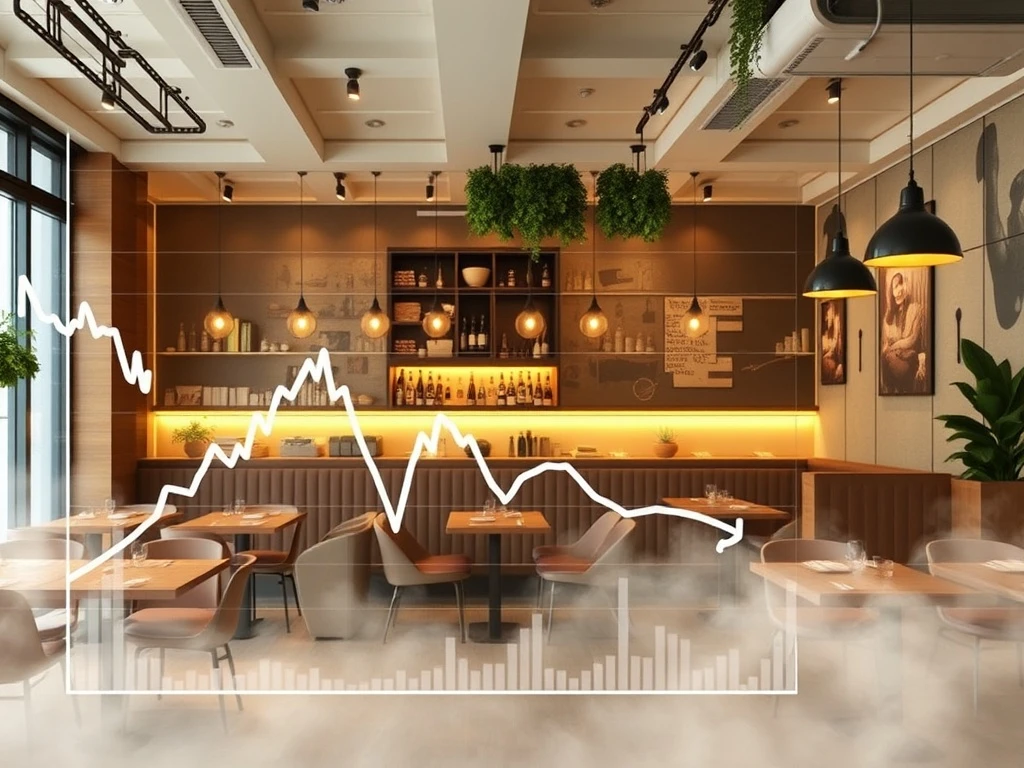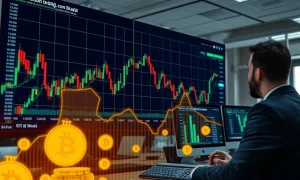Investors closely monitor market shifts. Recently, **Cava stock** experienced a significant plunge. This occurred after the popular Mediterranean fast-casual chain revised its annual sales outlook downwards. Cava Group Inc. reported this unexpected change. Its CEO, Brett Schulman, described consumers as navigating a ‘fog.’ This statement highlighted widespread economic uncertainty. For business leaders and entrepreneurs, understanding such market reactions is crucial. It reveals how consumer confidence directly impacts corporate performance and investment landscapes.
Cava Stock Plunge: The Immediate Aftermath
The announcement sent immediate ripples through the market. **Cava stock** plummeted sharply following the revised guidance. Shares fell by approximately 15% in extended trading. This marked a considerable setback for the company. Previously, Cava had been a market darling. Its strong performance since its IPO had attracted many investors. The sudden downturn, therefore, surprised many.
The core issue stemmed from Cava’s updated financial projections. The company now anticipates lower revenue for the fiscal year. This revision reflects a more cautious outlook. It suggests a slowdown in consumer spending. Specifically, the updated guidance projects full-year revenue between $730 million and $732 million. The previous forecast was higher, ranging from $735 million to $745 million. This adjustment, though seemingly small, signals underlying challenges. It impacts investor confidence directly.
Understanding the Sales Outlook Revision
Cava’s decision to cut its sales outlook was not made lightly. The company cited several contributing factors. Primarily, management pointed to a shift in consumer behavior. High inflation continues to erode purchasing power. Consequently, consumers are becoming more discerning. They are prioritizing essential spending over discretionary items. This includes dining out.
Furthermore, increased competition within the fast-casual segment plays a role. Many new players are entering the market. Existing chains are also intensifying their promotional activities. This creates a challenging environment for growth. Cava also noted a moderation in same-store sales growth. This metric is vital for restaurant chains. It measures sales at locations open for at least a year. A slowdown here indicates reduced customer traffic or smaller average checks.
Key reasons for the revision include:
- Persistent Inflation: Higher prices for goods and services reduce consumer disposable income.
- Consumer Caution: Economic uncertainty leads to more conservative spending habits.
- Market Saturation: Increased competition in the fast-casual dining sector.
- Moderated Growth: Slower same-store sales compared to previous periods.
The CEO’s ‘Fog’ Metaphor: Consumer Behavior in Focus
CEO Brett Schulman’s description of consumers navigating a ‘fog’ resonated deeply. This metaphor captures the current economic ambiguity. It suggests a lack of clear visibility for consumers. They face unpredictable economic conditions. This includes fluctuating interest rates and job market uncertainties. Such an environment makes long-term financial planning difficult. Consumers, therefore, adopt a wait-and-see approach.
This ‘fog’ directly impacts discretionary spending. People might choose to cook at home more often. They might also opt for less expensive dining options. This trend affects restaurant chains like Cava. It reduces their foot traffic and average transaction values. The CEO’s comment acknowledges this broader macroeconomic challenge. It highlights that Cava’s performance is not isolated. It reflects wider consumer sentiment. Understanding this ‘fog’ is key to predicting future market trends. It impacts various consumer-facing businesses.
Broader Market Context: Restaurant Industry Trends
Cava’s experience is not unique. The broader restaurant industry faces significant headwinds. Many chains report similar challenges. Labor costs remain high. Ingredient prices continue to fluctuate. Moreover, consumer preferences are evolving. There is a growing demand for value and convenience. Quick-service restaurants (QSRs) and fast-casual concepts are particularly sensitive to these shifts.
The industry is witnessing a bifurcation. Value-oriented chains often perform better during economic downturns. Premium fast-casual concepts, however, might struggle. They depend on consumers’ willingness to pay a bit more. Cava occupies this premium fast-casual niche. Therefore, it is more susceptible to shifts in discretionary spending. Other companies in the sector are also re-evaluating their strategies. They aim to attract and retain customers in this challenging climate. This includes adjusting pricing and enhancing loyalty programs. The outlook for **Cava stock** is thus tied to these broader industry dynamics.
Navigating Economic Headwinds: Cava’s Strategy
Despite the revised outlook, Cava is not standing still. The company is actively implementing strategies. It aims to navigate the current economic climate. Management emphasizes operational efficiency. They are focusing on cost management initiatives. This includes optimizing supply chains. It also involves streamlining in-store operations. These efforts aim to protect profit margins.
Furthermore, Cava continues its expansion plans. The company still intends to open new restaurants. This strategic growth demonstrates long-term confidence. They believe in the enduring appeal of their brand. Menu innovation also remains a priority. Cava introduces new seasonal items. They also offer limited-time offers. These initiatives aim to drive customer engagement. They encourage repeat visits. Loyalty programs are also being strengthened. These programs reward frequent customers. They incentivize continued patronage. These combined efforts seek to stabilize **Cava stock** performance.
Investor Reactions and Future Outlook for Cava Stock
The market’s reaction to Cava’s revised outlook was swift. Analysts are now re-evaluating their price targets. Some maintain a positive long-term view. They cite Cava’s strong brand and loyal customer base. Others adopt a more cautious stance. They highlight the ongoing macroeconomic uncertainties. The future trajectory of **Cava stock** will depend on several factors. These include consumer spending trends and inflation rates. The company’s ability to execute its growth strategy is also crucial.
Investors will closely monitor Cava’s upcoming earnings reports. These reports will provide further insights. They will reveal whether the company can stabilize its sales. They will also show if it can improve profitability. The stock’s recovery may be gradual. It hinges on broader economic improvements. It also depends on Cava’s specific operational successes. The market remains volatile. Therefore, careful consideration is essential for potential investors.
Key Metrics to Watch for Cava Stock Investors
For those holding or considering **Cava stock**, several key performance indicators warrant close attention. Monitoring these metrics provides a clearer picture of the company’s health. It also helps assess its ability to rebound. Understanding these figures is essential for informed investment decisions.
Important metrics include:
- Same-Store Sales Growth: This shows the sales performance of existing restaurants. Positive growth indicates increasing customer engagement.
- New Unit Openings: The pace and success of new restaurant launches. This reflects expansion strategy execution.
- Restaurant-Level Profitability: Margins at individual restaurant locations. This indicates operational efficiency.
- Average Unit Volumes (AUVs): The average annual sales per restaurant. Higher AUVs suggest stronger demand.
- Digital Sales Mix: The percentage of sales coming from online orders. This highlights digital engagement and convenience.
- Customer Traffic Trends: Actual foot traffic or order counts. This directly impacts revenue.
These metrics offer a comprehensive view. They help investors evaluate Cava’s resilience. They also gauge its potential for future growth. The company’s ability to improve these figures will be critical for its stock performance.
In conclusion, Cava’s recent sales outlook cut and subsequent **Cava stock** tumble reflect a challenging economic environment. The CEO’s ‘fog’ metaphor aptly describes consumer uncertainty. This impacts discretionary spending across the restaurant industry. While Cava faces headwinds, the company is implementing strategic measures. These include operational efficiencies and continued expansion. Investors must monitor key metrics. The path forward for Cava will depend on broader economic conditions. It also relies on the company’s ability to adapt and execute its plans effectively. The market will closely watch its progress in the coming quarters.
Frequently Asked Questions (FAQs)
Why did Cava stock tumble recently?
Cava stock tumbled after the company revised its annual sales outlook downwards. This adjustment indicated a more cautious forecast for revenue. The CEO cited a ‘fog’ of consumer uncertainty as a primary reason.
What does Cava’s CEO mean by consumers navigating a ‘fog’?
CEO Brett Schulman used the ‘fog’ metaphor to describe current economic ambiguity. Consumers face unpredictable conditions like inflation and interest rate fluctuations. This leads to cautious spending habits and reduced discretionary purchases.
How does the revised sales outlook impact Cava’s future?
The revised sales outlook suggests slower growth than previously anticipated. It indicates challenges in attracting and retaining customers amid economic pressures. This could affect future profitability and investor confidence in **Cava stock**.
What strategies is Cava implementing to address these challenges?
Cava is focusing on operational efficiencies and cost management. The company also continues its expansion plans. Additionally, it prioritizes menu innovation and strengthens its loyalty programs to drive customer engagement and sales.
Is Cava stock still a good investment?
Investing in Cava stock involves evaluating current market conditions and company strategies. While it faces headwinds, its long-term potential depends on economic recovery and successful execution of its plans. Investors should conduct thorough research and consider their risk tolerance.
What key metrics should investors watch for Cava?
Key metrics for Cava stock investors include same-store sales growth, new unit openings, restaurant-level profitability, average unit volumes (AUVs), digital sales mix, and customer traffic trends. These indicators provide insight into the company’s performance and health.








